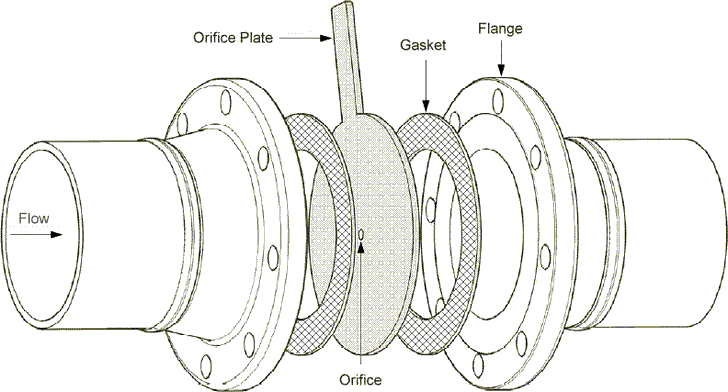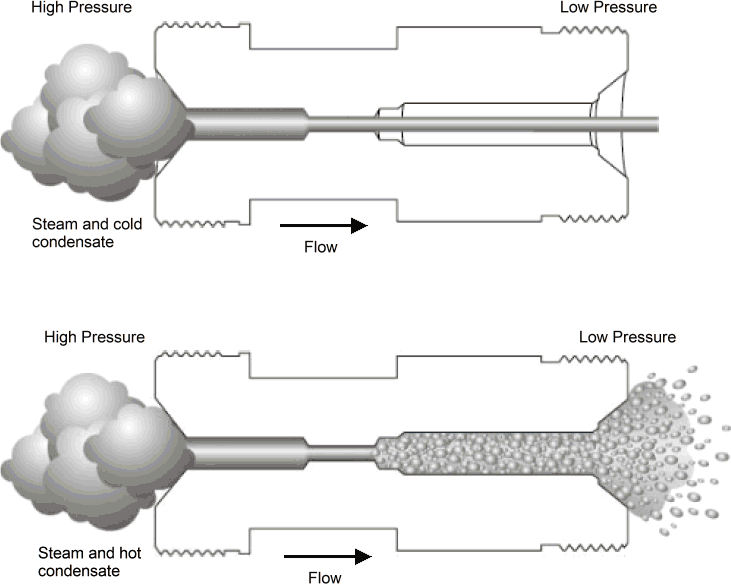Types of Steam Traps
Orifice Plate Steam Traps
The big difference with all other types of steam traps is that orifice plate steam traps have no moving parts. The operation of the orifice trap is mainly based on the difference in density between water and steam. At low pressures, the density of condensate is about 1000 greater than that of steam. In case of a small orifice, the condensate flows with much lower velocity through the opening, then steam.
If both media are present, which in principle for saturated steam systems is always the case, the much denser condensate will stop the steam. The consequence of this is, no fresh steam will leak through the trap.
An orifice plate steam trap is a relatively simple condensate removal device. Its design includes a thin metal plate with a small-diameter hole through the center. The image below shows a typical orifice plate steam trap installation.
The plate keeps live steam from flowing, and the hole or orifice allows either condensate or a small amount of live steam to escape. When orifice plate steam traps are properly sized for the flow conditions, they can function properly, but they are not suitable for all applications. Steam will escape when no condensate is present, and condensate backups can occur at start up and during periods of high demand. Orifice plate steam traps are best suited for situations where the pressure difference across the plate and the condensate load remain constant.

Advantages and Disadvantages of Orifice plate Steam Traps
Advantages
- Can be used for high-pressure steam applications
- Performance can be computed if the condensate load and inlet and outlet pressures are known
- Continuous discharge
- No moving parts
- Easy to maintain
- Cannot fail open, but erosion can gradually cause an increase in the orifice diameter
- Relatively low initial cost
- Resistant to damage by water hammer and thermal shock
- Pressure drop across the orifice reduces potential for overpressure of the downstream condensate system
- Resistant to freeze damage
- Can be mounted in several positions
Disadvantages
- Usual failure mode is closed due to plugging or blockage by dirt or debris
- Screen or strainer may be required to reduce possibility of plugging or blockage
- Live steam losses are usually small when the orifice is properly sized, but wear and erosion can enlarge the orifice and cause excessive loss of live steam
- Orifice opening cannot be adjusted to accommodate varying condensate loads
- Automatic or manual drain valve may be required to accommodate large condensate loads that occur during start up or periods of high demand
- Air can only be discharged very slowly during start up
- Engineering is required to select the appropriate size orifice for a particular application (ineffective if oversized or undersized)
- Consequences of live steam in the return system must be evaluated
- Difficult to field check because of continuous discharge
- Does not function effectively when back pressure is excessively high
- If the load is likely to vary by a factor of 2 or 3, the orifice plate steam trap may not be cost-effective because waterlogging or flooding is possible or excessive steam may escape
Venturi Orifice Design
The venturi orifice designed steam traps, like those produced by Thermal Energy International, have been proven to be the most efficiently designed steam traps (GEM® Condensate Return System) on the market providing an average reduction of 11.5% in the portion of the boiler fuel bill that is used to generate trapped steam.
How GEM® Traps work
 Image(s).. Thermal Energy International
Image(s).. Thermal Energy InternationalWhile the venturi orifice design retains its initial efficiency indefinitely, the mechanical trap, with its moving parts, begins to gradually deteriorate. With mechanical steam traps, when heat from steam is lost, vapour condenses to the bottom of the pipe and finally makes its way to the mechanical trap.
With the venturi orifice trap, the difference in density between steam and condensate and the continuous flow preferentially discharges the higher density condensate resulting in significantly less condensed water on the heat transfer side of the equipment. This also maintains the steam on the heat transferring side of the equipment resulting in better thermal efficiency.
Unlike a mechanical trap, as the venturi orifice steam trap enables continuous condensate discharge, the trap is equipped with an orifice, sized to the application. Therefore the live steam loss through a venturi orifice trap is significantly lower than the loss through a conventional mechanical trap, even when new.
Through the correct application of venturi throat design and orifice size, the capacity of the venturi orifice design can be self-regulated, dependant on load, and operated from the maximum running conditions to zero. This provides greatly increased capacity during start up.
Now becoming the steam trap of choice for industrial and commercial applications, the venturi orifice steam trap effectively drains condensate from the steam system. As it has no moving parts to wedge open or fail, it provides the ultimate in reliability necessitating only minimal maintenance and requiring no spares, testing or monitoring equipment. Since the trap can handle variable loads and accommodate wide load changes it is suitable for a large range of applications.
Venturi orifice steam traps are usually manufactured from high-grade corrosion resistant stainless steel as standard and are performance guaranteed for 10 years, obviating the need for repair or replacement.
Many companies carry out a steam trap inspection only once or twice a year, by which time at least 10% of their steam traps will have failed open, shut or partly open. Losses can include not only wasted energy but also replacement of damaged equipment and misuse of man-hours.
Fortunately, installing the low maintenance venturi orifice steam traps can avert many of these potential losses.
Remark(s) of the Author...
Kuwait refinery switches 1750 steam traps
KuwaitSeptember 2010 - Faced with the challenge of constantly repairing and replacing thousands of mechanical steam traps, KNPC's Shauiba Refinery in Kuwait has converted 1,750 mechanical traps to Thermal Energy International's (TEI) GEM Venturi Orifice design.
With the switch, KNPC, a subsidiary of the Kuwait Petroleum Association, has seen the HP hot condensate header pressure drop from highs of 175 psig to just 90 psig.
Commissioned in 1968, Shuaiba Refinery, 50 km south of Kuwait City, produces around 30 types of light, medium and heavy petroleum products. These consist of mainly gas, ordinary naphtha, various kinds of fuels such as high-octane gasoline, kerosene and ATK as well as automotive diesel, marine diesel, fuel oil and sulphur.
Steam is the refinery's primary means of transporting energy from the numerous boilers and steam generators to the point of use. It is used throughout the oil refinery for applications ranging from trace heating systems designed to keep the product at the correct viscosity to large reboilers consuming many tonnes of steam per hour.
As the steam gives up its useful heat it condenses to water. The steam trap's function is to remove this water and air from the steam pipework.
At Shuaiba Refinery the mechanical steam traps were failing at a rate of over 10% per annum.. failing in either the open position, resulting in the trap passing live steam, or closed which prevents the discharge of condensate from the system.
According to TEI, when it was first approached by the Shuaiba Refinery, failed mechanical traps had caused the condensate return pressure to rise to 175 psig, preventing the 150 psig steam stem from being able to discharge.
During a recent unplanned boiler outage, the refinery was able to run on just two boilers which prior to the installation of the GEM Venturi Orifice steam traps would have resulted in a loss of steam pressure to the refinery's extremities and impacted on production.
"Use of GEM traps has resulted in an 85psig l reduction in the HP hot condensate header pressure as well as steam savings from the reduction in steam loss", said Habib M. Atesh, engineering and maintenance Manager at Shuaiba Refinery. "In addition GEM traps are superior as only the strainers require maintenance".
Reference(s) .. www.processengineering.co.uk